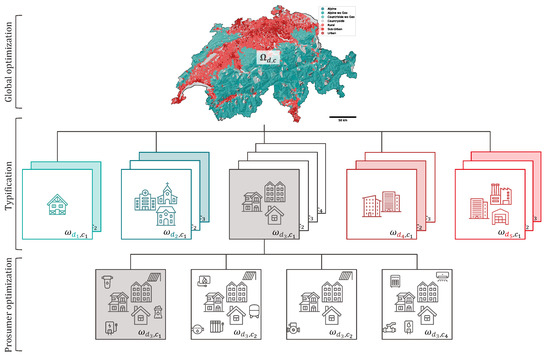2024-04-05 スイス連邦工科大学ローザンヌ校(EPFL)
<関連情報>
- https://actu.epfl.ch/news/swiss-energy-study-shows-transformative-potentia-2/
- https://www.mdpi.com/1996-1073/17/7/1718
- https://www.mdpi.com/1996-1073/17/4/910
- https://www.sciencedirect.com/science/article/pii/S0360544224008880
パワー・トゥ・ザ・ピープル 分散型エネルギーシステムにおける地区の役割について Power to the People: On the Role of Districts in Decentralized Energy Systems
Jonas Schnidrig,Arthur Chuat,,Cédric Terrier,François Maréchal and Manuele Margni
Energies Published: 3 April 2024
DOI:https://doi.org/10.3390/en17071718

Highlights
- Integration of decentralized models with a centralized national energy system framework.
- Strategic reduction in photovoltaic (PV) installation requirements and system cost through decentralized approaches.
- Optimization of self-consumption to minimize grid reinforcement needs.
- Identification of key trade-offs in PV integration and the importance of energy storage and grid management.
- Exploration of electrification strategies, power-to-methane technologies, and the use of existing gas grids to bridge decentralized and centralized systems.
Abstract
The transition towards renewable and decentralized energy systems is propelled by the urgent need to address climate concerns and advance sustainable development globally. This transformation requires innovative methods to integrate stochastic renewable sources such as solar and wind power and challenging traditional energy paradigms rooted in centralized and continuous energy production. The present study focuses on the Swiss energy system to explore the optimization of energy planning strategies that incorporate decentralized energy production within a centralized framework. Here, we show that a strategic approach to decentralization can significantly reduce annual system costs by 10% to CHF 1230 per capita and increase self-consumption to 68% of the decentralized PV production, emphasizing the need for a hybrid energy-planning model that balances centralized and decentralized models for enhanced system resilience, efficiency, and cost-effectiveness. This research underscores the strategic importance of diversifying energy sources, enhancing energy storage, improving grid flexibility, and laying a foundational framework for policy making and strategic planning. It encourages further investigation into climate impacts, technology synergy, and the integration of district heating, aiming to establish a resilient, sustainable, and autonomous energy future.
地域エネルギー・コミュニティから国家エネルギー・システムへ: グリッドを意識した技術経済分析 From Local Energy Communities towards National Energy System: A Grid-Aware Techno-Economic Analysis
Cédric Terrier,Joseph René Hubert Loustau,Dorsan Lepour and François Maréchal
Energies Published: 15 February 2024
DOI:https://doi.org/10.3390/en17040910

Abstract
Energy communities are key actors in the energy transition since they optimally interconnect renewable energy capacities with the consumers. Despite versatile objectives, they usually aim at improving the self-consumption of renewable electricity within low-voltage grids to maximize revenues. In addition, energy communities are an excellent opportunity to supply renewable electricity to regional and national energy systems. However, effective price signals have to be designed to coordinate the needs of the energy infrastructure with the interests of these local stakeholders. The aim of this paper is to demonstrate the integration of energy communities at the national level with a bottom–up approach. District energy systems with a building scale resolution are modeled in a mixed-integer linear programming problem. The Dantzig–Wolfe decomposition is applied to reduce the computational time. The methodology lies within the framework of a renewable energy hub, characterized by a high share of photovoltaic capacities. Both investments into equipment and its operation are considered. The model is applied on a set of five typical districts and weather locations representative of the Swiss building stock. The extrapolation to the national scale reveals a heterogeneous photovoltaic potential throughout the country. Present electricity tariffs promote a maximal investment into photovoltaic panels in every region, reaching an installed capacity of 67.2 GW and generating 80 TWh per year. Placed in perspective with the optimal PV capacity forecast at 15.4 GW at the national level, coordinated investment between local and national actors is needed to prevent dispensable expenses. An uncoordinated design is expected to increase the total costs for residential energy systems from 12% to 83% and curtails 48% of local renewable electricity.
典型的な地区構成の特定: 2段階のグローバル感度分析フレームワーク Identification of typical district configurations: A two-step global sensitivity analysis framework
Arthur Chuat, Cédric Terrier, Jonas Schnidrig, François Maréchal
Energy Available online:26 March 2024
DOI:https://doi.org/10.1016/j.energy.2024.131116

Highlights
•Energy carriers’ retail prices are the most influential parameters of a district energy system.
•Energy system configurations differ according to the consumed energy carrier and PV penetration.
•PV deployment is affected by electricity tariffs but not by technological implementations.
Abstract
The recent geopolitical conflicts in Europe have underscored the vulnerability of the current energy system to the volatility of energy carrier prices. In the prospect of defining robust energy systems ensuring sustainable energy supply in the future, the imperative of leveraging renewable indigenous energy sources becomes evident. However, as such technologies are integrated into the existing system, it is necessary to shift from the current centralized infrastructure to a decentralized production strategy. This paper presents a method to identify a panel of technological solutions at the district level, intended to reduce complexity for the integration of decentralized models into a national-scale model. The framework’s novelty lies in combining a global sensitivity analysis for solution generation with clustering to identify typical configurations. The global sensitivity analysis is performed on a mixed integer linear programming model, which optimally sizes and operates district energy systems. The sensitivity analysis determines the most influential parameters of the model using the Morris method and provides a representative sampling of the solution space by leveraging the Sobol sampling strategy. The latter is then clustered using a density-based algorithm to identify typical solutions. The framework is applied to a suburban and residential Swiss neighborhood. The first outcome of the research is the high sensitivity of the model to energy carrier prices. As a result, Sobol’s sampling space separates itself into two system types: those based on a natural gas boiler and those relying on a combination of electrical heaters and heat pumps. For both types, the electricity demand is either fulfilled by PV panels or electricity imports. The identified configurations showcase that the framework successfully generates a panel of solutions composed of various system configurations and operations being representative of the overall solution space.



